In the assessment of risk in the global financial markets, the focus shifted from sovereign
debt crisis to concerns regarding the slowdown in economic recovery. This change in
assessment of risk of the global investors impacted Indian financial markets through
two different channels, viz. appreciation of the Indian Rupee and rise in equity prices
due to sharp increase in portfolio flows. The transmission of higher policy interest rates
increasingly became effective, albeit with a lag. The deficit liquidity conditions impacted
various segments of financial markets viz. CPs, CDs, CBLO, Treasury Bills, government
securities and bank deposits. Activities in CPs market picked up in the post Base Rate
scenario as corporates explored alternative sources of finance. Housing prices in major
cities witnessed a rising trend.
V.1 The financial markets in advanced
economies had started to price in
uncertainties related to the sovereign debt
crisis in the Euro area and its possible
spillover impact on the banking sector, when
renewed concerns regarding slowdown in
recovery adversely affected the investor
confidence. The financial markets in
emerging market economies (EMEs),
however, showed signs of further
strengthening mainly on account of their
strong growth potential vis-à-vis advanced
economies. As a result, capital flows to
EMEs strengthened, thereby exerting
pressure on currencies to appreciate and
asset prices to remain upbeat. The US dollar
depreciated against most of the major
currencies, most notably against the
Japanese Yen. Currency markets remained
volatile and received greater market
attention based on expectations about
country specific policy responses to deal
with the costs of appreciating exchange rate.
V.2 The Indian financial markets
remained largely stable, with range-bound
turnover and decline in volatility. Call rates
gradually firmed up, in step with changes
in policy rates and deficit liquidity conditions.
The LAF corridor was narrowed with a view to containing volatility. Both CPs and CDs
markets witnessed higher issuances, as
lenders (through CDs) and borrowers
(through CPs) scouted for cheaper funds
against the backdrop of sustained increase
in policy rates. The yield in G-Sec market
hardened in the initial part of the second
quarter of 2010-11 reflecting hike in policy
rates, tight liquidity conditions and high
inflation. Thereafter, the yields softened as
liquidity conditions improved and concerns
over Euro area receded. The Indian Rupee
appreciated against the US dollar and the
Indian stock prices rose on the back of
substantial portfolio inflows. The quarterly
House Price Index of the Reserve Bank
suggests that prices in the housing market,
especially in Tier I cities continued to show
signs of acceleration, even as prices in Tier
II cities registered some moderation.
International Financial Markets
V.3 The concerns relating to sovereign
debt crisis, which adversely affected the
global financial market conditions since end
2009, considerably receded by the
beginning of the third quarter of 2010. By
end-July, however, concerns relating to the global growth outlook and its implications
for asset prices assumed centre stage.
Increasing evidence of slowdown in
economic recovery in the US and other
advanced economies led to lower inflation
expectations and falling bond yields (Chart
V.1a). The spread between corporate bond yield and G-sec yield widened, especially
after September 2010 (Chart V.1d).
Increasing concerns relating to slowdown
in the US and other advanced economies
led to depreciation of the US dollar against
all major currencies, especially against the
Japanese Yen (Chart V.1h).
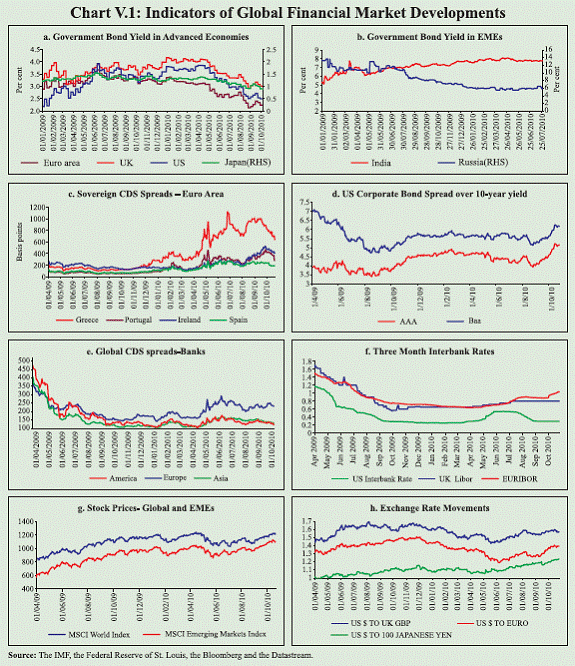 |
V.4 Asset prices in EMEs registered
significant gains as portfolio flows to these
economies revived on the possibility of
better returns in these countries. Their
currencies also witnessed appreciation
pressures (Table V.1).
V.5 The developments in the global
financial markets spilled over to the Indian
markets, particularly the equity and foreign
exchange market. With deterioration in the
outlook for growth in the advanced
economies, there was a substantial increase
in capital inflows led by FIIs. This
contributed to significant increase in stock
prices, besides leading to appreciation of
exchange rate of the rupee against the US
dollar. Improved global credit market
conditions, and the widening interest rate
differential facilitated higher access to
ECBs by corporates. Financial markets in
India, besides reflecting the global trend,
were largely conditioned by the domestic
growth-inflation outlook, monetary policy
stance and the fiscal position.
Table V.1 : Currency and Stock Price Movement in EMEs |
(Per cent) |
Items |
End-March 2009 @ |
End-March 2010 @ |
End-Oct 27 2010* |
Items |
End-March 2009 @ |
End-March 2010 @ |
End-Oct 27 2010* |
1 |
2 |
3 |
4 |
1 |
2 |
3 |
4 |
Appreciation (+)/Depreciation (-) of Currency per US Dollar |
Stock Price Variations |
Argentine Peso |
-14.8 |
-4.2 |
-2.0 |
Brazil (Bovespa) |
-32.9 |
71.9 |
0.3 |
Brazilian Real |
-23.8 |
24.6 |
5.4 |
China (Shanghai Composite) |
-31.7 |
31.0 |
-3.6 |
Chinese Yuan |
2.7 |
0.14 |
2.0 |
India (BSE Sensex) |
-37.9 |
80.5 |
14.5 |
Indian Rupee |
-21.6 |
12.9 |
1.4 |
Indonesia (Jakarta Composite) |
-41.4 |
93.7 |
30.5 |
Indonesian Rupiah |
-20.4 |
27.0 |
2.1 |
Malaysia (KLSI) |
-30.1 |
51.3 |
13.5 |
Japanese Yen |
2.0 |
5.2 |
14.2 |
Russia (RTS) |
-66.4 |
128.0 |
0.7 |
Malaysian Ringgit |
-12.6 |
11.4 |
5.3 |
Singapore (Straits Times) |
-43.5 |
69.9 |
8.2 |
Mexican Peso |
-24.8 |
14.0 |
-0.5 |
South Korea (KOSPI) |
-29.2 |
40.3 |
12.8 |
Russian Ruble |
-30.7 |
14.9 |
-3.5 |
Taiwan (Taiwan Index) |
-39.2 |
52.0 |
4.7 |
South Korea Won |
-28.0 |
21.7 |
1.2 |
Thailand (SET Composite) |
-47.2 |
82.6 |
24.9 |
Thai Baht |
-11.4 |
9.8 |
7.9 |
|
|
|
|
Turkish Lira |
-21.7 |
10.1 |
-23.2 |
|
|
|
|
@: Year-on-year variation. * Variation over End-March.
Source : Bloomberg, IFS, IMF. |
Domestic Financial Markets
V.6 Strong domestic macroeconomicfundamentals and expectation of sustainedhigh growth provided the necessary comfortto the markets. The transaction volumes inthe markets remained range bound althoughthe spreads/volatility generally declined( Table V.2 and Chart V.2).
Money Market
V.7 The money market remained orderly
during the second quarter of 2010-11. The
call rate firmed up, starting from end-May
2010 due to the tightening of liquidity
conditions on account of 3G/BWA auctions
and advance tax payments. The call rate
hovered around the upper bound of the LAF
corridor till July 2010 as deficit liquidity
conditions persisted due to the high Central
Government cash balances. The call rate
declined towards the end of August and early
September with the easing of liquidity
conditions. As the transmission of higher
policy interest rates increasingly became effective and the liquidity conditions
tightened, the call rate again firmed up from
the middle of September 2010, and breached
the upper bound of the informal LAF
corridor. With a view to containing volatility
in the call rate, the LAF corridor was reduced
from 150 bps to 100 bps in two stages since
July 2010(Chart V.3). The call rate has
hovered around the upper bound of the
informal corridor during October 2010.
Table V.2 : Domestic Financial Markets at a Glance |
Year/ Month |
Call Money Market |
Govt. Securities Market |
Forex Market |
Liquidity
Management |
Stock Markets |
Daily Turn over (`crore) |
Call Rates* (Per cent) |
Daily Turn over^ (` crore) |
10-Year@ (Per cent) |
Daily Inter-bank Turnover (US$ mn) |
Exch ange rate@ (` / US$) |
RBI’s net purchase (+)/sale (-) (US$ mn) |
MSS Out- standing# (` crore) |
Average Daily LAF (` crore) |
Daily BSE Turn over (` crore) |
Daily NSE Turn over (` crore) |
BSE Sensex ** |
CNX Nifty** |
1 |
2 |
3 |
4 |
5 |
6 |
7 |
8 |
9 |
10 |
11 |
12 |
13 |
14 |
2008-09 |
22,436 |
7.06 |
10,879 |
7.54 |
34,812 |
45.92 |
-34,922† |
1,48,889 |
2,885 |
4,498 |
11,325 |
12303 |
3713 |
2009-10 |
15,924 |
3.24 |
14,426 |
7.23 |
30,107 |
44.95 |
-2,635† |
23,914 |
1,00,015 |
5,651 |
16,959 |
15585 |
4658 |
Apr-09 |
21,820 |
3.28 |
15,997 |
6.55 |
27,796 |
50.06 |
-2,487 |
75,146 |
1,01,561 |
5,232 |
15,688 |
10911 |
3360 |
May-09 |
19,037 |
3.17 |
14,585 |
6.41 |
32,227 |
48.53 |
-1,437 |
45,955 |
1,25,728 |
6,427 |
19,128 |
13046 |
3958 |
Jun-09 |
17,921 |
3.21 |
14,575 |
6.83 |
32,431 |
47.77 |
1,044 |
27,140 |
1,23,400 |
7,236 |
21,928 |
14782 |
4436 |
Jul-09 |
14,394 |
3.21 |
17,739 |
7.01 |
30,638 |
48.48 |
-55 |
22,159 |
1,30,891 |
6,043 |
18,528 |
14635 |
4343 |
Aug-09 |
15,137 |
3.22 |
9,699 |
7.18 |
27,306 |
48.34 |
181 |
19,804 |
1,28,275 |
5,825 |
17,379 |
14415 |
4571 |
Sep-09 |
16,118 |
3.31 |
16,988 |
7.25 |
27,824 |
48.44 |
80 |
18,773 |
1,21,083 |
6,211 |
18,253 |
16338 |
4859 |
Oct-09 |
15,776 |
3.17 |
12,567 |
7.33 |
28,402 |
46.72 |
75 |
18,773 |
1,01,675 |
5,700 |
18,148 |
16826 |
4994 |
Nov-09 |
13,516 |
3.19 |
17,281 |
7.33 |
27,599 |
46.57 |
-36 |
18,773 |
1,01,719 |
5,257 |
16,224 |
16684 |
4954 |
Dec-09 |
13,302 |
3.24 |
14,110 |
7.57 |
27,439 |
46.63 |
0 |
18,773 |
68,522 |
4,671 |
13,948 |
17090 |
5100 |
Jan-10 |
12,822 |
3.23 |
12,614 |
7.62 |
32,833 |
45.96 |
0 |
9,944 |
81,027 |
6,162 |
17,813 |
17260 |
5156 |
Feb-10 |
13,618 |
3.17 |
12,535 |
7.79 |
34,040 |
46.33 |
0 |
7,737 |
78,661 |
4,125 |
12,257 |
16184 |
4840 |
Mar-10 |
17,624 |
3.51 |
8,544 |
7.94 |
32,755 |
45.50 |
0 |
3,987 |
37,640 |
4,751 |
13,631 |
17303 |
5178 |
Apr-10 |
16,374 |
3.49 |
14,242 |
8.01 |
36,821 |
44.50 |
0 |
2,737 |
57,150 |
4,696 |
13,828 |
19679 |
5295 |
May-10 |
16,786 |
3.83 |
24,225 |
7.56 |
40,243 |
45.81 |
0 |
922 |
32,798 |
3,940 |
12,937 |
16845 |
5053 |
Jun.-10 |
14,258 |
5.16 |
21,300 |
7.59 |
36,953 |
46.57 |
0 |
317 |
-47,347 |
4,204 |
13,005 |
17300 |
5188 |
July.-10 |
18,954 |
5.54 |
13,691 |
7.69 |
33,978 |
46.84 |
0 |
254 |
-46,653 |
4,225 |
12,661 |
17848 |
5360 |
Aug.-10 |
15,916 |
5.17 |
16,919 |
7.93 |
36,193 |
46.57 |
– |
0 |
-1,048 |
5,131 |
14,182 |
18177 |
5457 |
Sept.-10 |
17,212 |
5.50 |
16,215 |
7.96 |
37,249 |
46.06 |
– |
0 |
-24,155 |
5,185 |
15,708 |
19353 |
5811 |
*:Average of daily weighted call money borrowing rates.
^: Average of daily outright turnover in Central Government dated securities. @ : Average of closing rates.
#: Average of weekly outstanding MSS. **:Average of daily closing indices. † :Cumulative for the financial year.
P: Provisional. – : Not available. LAF: Liquidity Adjustment Facility.
MSS : Market Stabilisation Scheme.
BSE : Bombay Stock Exchange Limited.
NSE : National Stock Exchange of India Limited.
Note : In column 10, (-) indicates injection of liquidity, while (+) indicates absorption of liquidity. |
V.8 Rates in the collateralised segments
continued to move in tandem with the call
rate, albeit below it, during the second
quarter of 2010-11. Transaction volumes in
the collateralised borrowing and lending obligation (CBLO) and market repo
segments remained high during this period
reflecting active market conditions
(TableV.3). As in the previous quarter, banks
continued to remain the major borrowers in
the collateralised segment whereas mutual
funds (MFs) remained the major lenders of
funds in that segment. The share of MFs in
the total lending in the collateralised segment
declined during June-August 2010 from the
level in April-May 2010. The collateralised
segment of the money market continued to
remain the predominant segment, accounting
for more than 80 per cent of the total volume
during the second quarter of 2010-11.
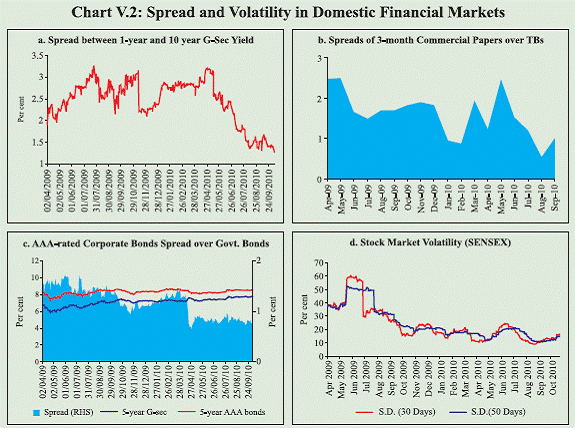 |
V.9 The average fortnightly issuance of
certificates of deposit (CDs) remained
higher during the second quarter as
compared with the previous quarter. The higher issuance of CDs is reflective of
banks’ efforts to raise bulk deposits at lower
cost as deposit interest rates started moving
northward. In line with the movement of rates in other money market segments, the
weighted average discount rate (WADR) of
CDs increased. The average fortnightly
issuance of Commercial Paper (CPs) also
remained higher during the second quarter
as compared with the previous quarter.
‘Leasing and Finance’ and manufacturing corporates were major issuers of CPs (Table
V.4). The higher issuance of CPs suggests
efforts by the commercial sector to raise
resources from alternative sources of
finance in the face of tight liquidity
conditions. The WADR in CPs also
increased during the quarter.
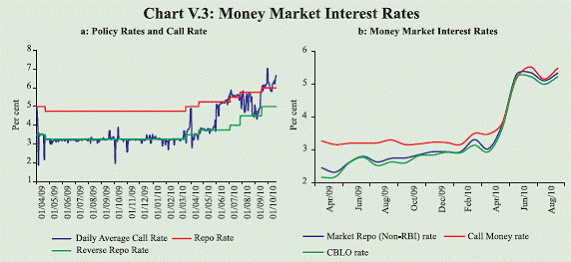 |
Table V.3 : Activity in Money Market Segments |
(` crore) |
Year/Month |
Average Daily Volume (One Leg) |
Commercial Paper |
Certificates of Deposit |
Call |
Market
Repo |
CBLO |
Total
(Col.2
to 4) |
Money
Market
Rate
(%)* |
Term
Money |
Outstanding |
WADR
(%) |
Outstanding |
WADR
(%) |
1 |
2 |
3 |
4 |
5 |
6 |
7 |
8 |
9 |
10 |
11 |
Apr-09 |
10,910 |
20,545 |
43,958 |
75,413 |
2.41 |
332 |
52,881 |
6.29 |
2,10,954 |
6.48 |
May-09 |
9,518 |
22,449 |
48,505 |
80,472 |
2.34 |
338 |
60,740 |
5.75 |
2,18,437 |
6.20 |
Jun-09 |
8,960 |
21,694 |
53,553 |
84,207 |
2.69 |
335 |
68,721 |
5.00 |
2,21,491 |
4.90 |
Jul-09 |
7,197 |
20,254 |
46,501 |
73,952 |
2.83 |
389 |
79,582 |
4.71 |
2,40,395 |
4.96 |
Aug-09 |
7,569 |
23,305 |
57,099 |
87,973 |
2.62 |
461 |
83,026 |
5.05 |
2,32,522 |
4.91 |
Sep-09 |
8,059 |
27,978 |
62,388 |
98,425 |
2.73 |
381 |
79,228 |
5.04 |
2,16,691 |
5.30 |
Oct-09 |
7,888 |
23,444 |
58,313 |
89,645 |
2.70 |
225 |
98,835 |
5.06 |
2,27,227 |
4.70 |
Nov-09 |
6,758 |
22,529 |
54,875 |
84,162 |
2.87 |
191 |
1,03,915 |
5.17 |
2,45,101 |
4.86 |
Dec-09 |
6,651 |
20,500 |
55,338 |
82,489 |
2.91 |
289 |
90,305 |
5.40 |
2,48,440 |
4.92 |
Jan-10 |
6,411 |
14,565 |
50,571 |
71,547 |
2.97 |
404 |
91,564 |
4.80 |
2,82,284 |
5.65 |
Feb-10 |
6,809 |
19,821 |
63,645 |
90,275 |
2.95 |
151 |
97,000 |
4.99 |
3,09,390 |
6.15 |
Mar-10 |
8,812 |
19,150 |
60,006 |
87,968 |
3.22 |
393 |
75,506 |
6.29 |
3,41,054 |
6.07 |
Apr-10 |
8,187 |
20,319 |
50,891 |
79,397 |
3.03 |
423 |
98,769 |
5.37 |
3,36,807 |
5.56 |
May-10 |
8,393 |
17,610 |
42,274 |
68,277 |
3.72 |
330 |
1,09,039 |
6.85 |
3,40,343 |
5.17 |
Jun-10 |
7,129 |
9,481 |
31,113 |
47,723 |
5.22 |
447 |
99,792 |
6.82 |
3,21,589 |
6.37 |
Jul-10 |
9,477 |
12,011 |
29,102 |
50,590 |
5.33 |
385 |
1,12,704 |
6.93 |
3,24,810 |
6.69 |
Aug-10 |
7,958 |
15,553 |
45,181 |
68,692 |
5.05 |
281 |
1,26,549 |
7.32 |
3,41,616 |
7.17 |
Sept-10 |
8,606 |
15,927 |
53,223 |
77,756 |
5.29 |
617 |
1,12,003 |
7.82 |
3,37,322 |
7.34 |
CBLO: Collateralised Borrowing and Lending Obligation. WADR: Weighted Average Discount Rate.
*: Weighted average rate of call, market repo and CBLO. |
Table V.4 : Major Issuers of Commercial Paper |
(` crore) |
End of Period |
Leasing and Finance |
Manufacturing |
Financial Institutions |
Total
Outstanding |
Amount |
Share (%) |
Amount |
Share(%) |
Amount |
Share(%) |
1 |
2 |
3 |
4 |
5 |
6 |
7 |
8 (=2+4+6) |
Mar-09 |
27,183 |
62 |
12,738 |
29 |
4,250 |
10 |
44,171 |
Jun-09 |
34,437 |
50 |
23,454 |
34 |
10,830 |
16 |
68,721 |
Sep-09 |
31,648 |
40 |
31,509 |
40 |
16,071 |
20 |
79,228 |
Dec-09 |
36,027 |
40 |
42,443 |
47 |
11,835 |
13 |
90,305 |
Mar-10 |
39,477 |
52 |
22,344 |
30 |
13,685 |
18 |
75,506 |
Jun-10 |
42,572 |
43 |
43,330 |
43 |
13,890 |
14 |
99,792 |
Sep-10 |
58,098 |
52 |
40,486 |
36 |
13,420 |
12 |
1,12,003 |
Government Securities Market
V.10 Reflecting the policy of front
loading of market borrowings during the first
half of the year, the Government of India
has completed 63 per cent of its borrowing
programme for 2010-11, ensuring that there
is no crowding-out in the latter half of the
year when the private credit demand is
normally robust. While the average maturity
of debt issuances increased during 2010-11
(up to September 2010), the weighted
average yield also firmed up as compared to
the corresponding period of the previous
year (Table V.5). In case of borrowings by
the states, 18 states have raised `49,362 crore
on a gross basis during the first half of the
year, which constituted about 32 per cent of
the gross allocation for 27 States under the
scheme of borrowings for 2010-11 as
compared with 53.5 per cent during the
corresponding period of 2009-10.
V.11 The prevalence of tight liquidity
conditions on account of outflow following
the 3G/BWA auctions and the rise in policy
rates have resulted in an upward movement
in the primary market yields for short and
medium term securities, while some softening was observed at the longer end
during the second quarter in anticipation of
reduction in governments’ market
borrowings.
V.12 Taking into account the need for
fiscal consolidation and other additional
revenues generated so far for financing the
fiscal deficit, the net market borrowings of
the Government of India have been scaled
down by `10,000 crore as per the indicative
borrowing calendar issued for the second
half of 2010-11. Based on the demand
pattern of the market participants as also the
scope for issuance of securities in different
maturities, the maturity profile of dated
securities is set to be elongated in the
calendar. As regards the States borrowings,
about one third of the gross allocations for
the States have been raised till the end of
the second quarter. Taking into account the
comfortable cash balances of the State
Governments and the borrowing programme
adopted by the States so far, it appears that
there may be a moderation in their
borrowings during the current financial year.
It is expected that the calibrated strategies
adopted in the borrowing programme of the Government of India and the State
Governments would ensure its completion
in a non-disruptive manner.
Table V.5 : Issuances of Central and State Government Dated Securities |
|
2007-08 |
2008-09 |
2009-10 |
2009-10$ |
2010-11$ |
1 |
2 |
3 |
4 |
5 |
6 |
Central Government |
|
|
|
|
|
Gross amount raised (` crore) |
1,56,000 |
2,61,000 |
4,18,000 |
2,95,000 |
2,84,000 |
Devolvement on Primary Dealers (` crore) |
957 |
10,773 |
7,219 |
6,050 |
3,563 |
Bid-cover ratio (Range) |
1.6-4.8 |
1.2-4.5 |
1.4-4.3 |
1.4-3.6 |
1.4-3.9 |
Weighted average maturity (years) |
14.9 |
13.8 |
11.2 |
10.9 |
11.3 |
Weighted average yield (per cent) |
8.1 |
7.7 |
7.2 |
7.1 |
7.8 |
State Governments |
|
|
|
|
|
Gross amount raised (` crore) |
67,779 |
1,18,138 |
1,31,122 |
63,212 |
49,362 |
Cut-off yield |
7.9-8.9 |
5.8-9.9 |
7.0-8.6 |
7.0-8.4 |
8.1-8.6 |
Weighted average yield (per cent) |
8.3 |
7.9 |
8.1 |
7.9 |
8.3 |
$: Up to September 30. |
Table V.6 : Treasury Bills in the
Primary Market |
Year/
Month |
Notified
Amount
(`crore) |
91-day |
182-day |
364-day |
1 |
2 |
3 |
4 |
5 |
2008-09 |
2,99,000 |
7.10 |
7.22 |
7.15 |
2009-10 |
3,80,000 |
3.57 |
4.00 |
4.37 |
2010-11 (up to Sept. 30, 2010) |
1,49,500 |
5.27 |
5.56 |
5.74 |
Apr-10 |
36,000 |
4.14 |
4.64 |
5.07 |
May-10 |
36,000 |
4.39 |
4.76 |
4.92 |
Jun-10 |
15,000 |
5.29 |
5.31 |
5.49 |
Jul-10 |
13,000 |
5.51 |
5.86 |
5.99 |
Aug-10 |
33,000 |
6.15 |
6.41 |
6.48 |
Sept-10 |
16,500 |
6.10 |
6.41 |
6.59 |
V.13 The yield on 91-day Treasury Bills
firmed up by 81 basis points between June
and September 2010, whereas the yield on
both 182-day and 364-day Treasury Bills
increased by 110 bps during the same period
(Table V.6). Keeping in view the
comfortable cash balance of the
Government of India, the Reserve Bank, in consultation with the GoI, scaled down the
notified amount of Treasury Bills during the
second quarter. In addition, an amount of
`9,614 crore was bought back by the
Government as part of the cash
management operations during the quarter.
V.14 During Q2 of 2010-11, the G-Sec
yields generally hardened till the third week
of August 2010 amidst intermittent easing.
The hardening of yields was mainly on
account of hike in policy rates, tight liquidity
conditions and high inflation. Thereafter, the
yields declined as liquidity conditions
improved and concerns over Euro area
receded. Although liquidity conditions
tightened towards the middle of September
against the backdrop of quarter-end advance
tax outflows, the increase in the investment
limits of FIIs in the government securities
and corporate bonds and lower than
budgeted borrowing programme for the
second half of the current fiscal year
provided fillip to the market (Chart V.4).
During the month of October 2010, the
yields have risen on account of inflationary
concerns and tight liquidity conditions.
Credit Market
V.15 The spreads on corporate bonds
over the government bond yield declined
further in Q2 of 2010-11 over the levels
in Q1 of 2010-11, partly reflecting further
reduction in risk perception for corporates
due to improved growth outlook as well
as lower inflationary expectations
(Chart V.2c).
V.16 As part of the calibrated exit,
Reserve Bank increased its repo rate by 125
bps, reverse repo by 175 bps and CRR by
100 bps during February-September 2010.
In response to these policy rate changes,
72 SCBs raised their deposit rates in the
range of 25-125 bps during February-
October 15, 2010 across various maturities
(Table V.7). On the lending side, the benchmark prime lending rates (BPLR) of
SCBs remained unchanged between July
2009 and July 2010. Thereafter, several
SCBs increased their BPLR in the range of
25-75 bps during July-September, 2010.
V.17 In line with hike in policy rates,
several banks increased their Base Rates by
10-50 basis points by October 2010. As
many as 53 banks with a share of 94 per
cent in total bank credit have fixed their
Base Rates in the range of 7.50-8.50 per
cent, indicating convergence in the Base
Rates announced by banks.
Foreign Exchange Market
V.18 The Indian rupee exhibited twoway
movement against major international
currencies during Q2 of 2010-11. It appreciated against the US Dollar, while
depreciated against the Pound Sterling,
Euro and Japanese Yen. During the quarter,
the rupee exhibited depreciating trend
against the US dollar up to the third week
of July 2010 and thereafter remained largely
range bound during August 2010. The
Rupee has generally appreciated since the
first week of September 2010 on the back
of pick-up in capital inflows and
strengthening of growth outlook (Chart
V.5a). The 1-month as well as 3-month
forward premia increased during the quarter
(Chart V.5b).
Table V.7 : Deposit and Lending Rates of Banks |
(Per cent) |
| |
Sep 2009 |
Dec 2009 |
Mar 2010 |
Jun 2010 |
Oct 15, 2010 |
1 |
2 |
3 |
4 |
5 |
6 |
1. |
Domestic Deposit Rate |
|
|
|
|
|
|
Public Sector Banks |
|
|
|
|
|
|
Up to 1 year |
1.00-7.00 |
1.00-6.25 |
1.00-6.50 |
1.00-6.25 |
1.00-7.00 |
|
> 1year-3 years |
6.50-8.00 |
6.00-7.25 |
6.00-7.25 |
6.00-7.25 |
7.00-7.75 |
|
> 3 years |
7.00-8.50 |
6.25-7.75 |
6.50-7.75 |
6.50-7.75 |
7.00-8.00 |
|
Private Sector Banks |
|
|
|
|
|
|
Up to 1 year |
2.00-7.50 |
2.00-6.75 |
2.00-6.50 |
2.00-6.50 |
2.50-7.25 |
|
> 1year-3 years |
6.00-8.75 |
5.25-7.50 |
5.25-7.75 |
6.25-7.50 |
6.50-8.25 |
|
> 3 years |
6.00-9.00 |
5.75-8.00 |
5.75-8.00 |
6.50-8.00 |
6.50-9.00 |
|
Foreign Banks |
|
|
|
|
|
|
Up to 1 year |
1.80-8.00 |
1.25-7.00 |
1.25-7.00 |
1.25-7.00 |
1.25-7.30 |
|
> 1year-3 years |
2.25-8.50 |
2.25-7.75 |
2.25-8.00 |
3.00-8.00 |
3.00-8.00 |
|
> 3 years |
2.25-9.50 |
2.25-8.50 |
2.25-8.75 |
3.00-8.50 |
3.00-8.25 |
2. |
BPLR/Base Rate |
|
|
|
|
|
|
1. Public Sector Banks |
11.00-13.50 |
11.00-13.50 |
11.00-13.50 |
11.00-13.50 |
7.50-8.50# |
|
2. Private Sector Banks |
12.50-16.75 |
12.50-16.75 |
12.50-16.75 |
12.50-16.75 |
7.00-9.00# |
|
3. Foreign Banks |
10.50-16.00 |
10.50-16.00 |
10.50-16.00 |
10.50-16.00 |
5.50-9.00# |
3. |
Actual Lending Rate* |
|
|
|
|
|
|
1. Public Sector Banks |
3.50-17.50 |
3.25-18.00 |
3.25-18.00 |
3.25-18.00 |
– |
|
2. Private Sector Banks |
4.10-26.00 |
3.50-25.84 |
3.00-28.00 |
2.80-26.00 |
– |
|
3. Foreign Banks |
2.76-25.50 |
3.50-22.00 |
3.60-23.00 |
3.60-25.00 |
– |
* : Interest rate on non-export demand and term loans above ` 2 lakh excluding lending rates at the extreme five per cent on
both sides.
# Base Rate system replaced BPLR system with effect from July 1, 2010. |
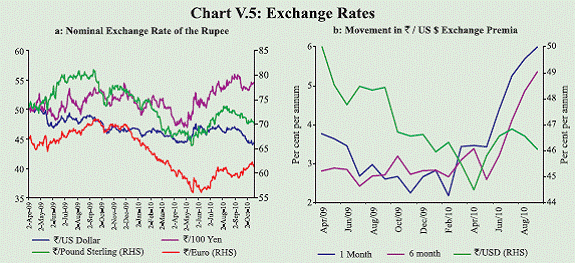 |
V.19 The turnover in both inter-bank and
merchant segments of the forex market
declined during July 2010 and recovered
thereafter since August 2010 (Chart V.6).
Equity and Housing Markets
V.20 Stock prices continued the bullish
trend during July-September on the back
of strong FII investments in equities. India,
along with other EMEs experienced strong
portfolio inflows as interest rate differential
between these countries and advanced economies turned more lucrative. Strong
macroeconomic fundamentals in the
Indian markets, buoyancy in the industrial
and services sector as also possibility of
further increase in rural demand on
expected better performance of the
agricultural sector were some of the pull
factors responsible for the FII inflows. As
at end-September 2010, the Sensex and the
Nifty both registered gains of 14.5 per cent
and 14.9 per cent, respectively, over end-
March 2010 (Table V.8).
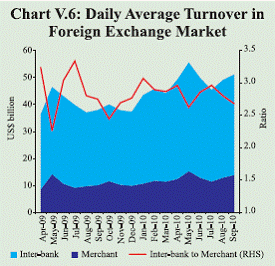 |
Table V.8 : Key Stock Market Indicators |
Indicator |
BSE |
NSE |
2008-09 |
2009-10 |
2009-10 (Apr-Sept) |
2010-11 (Apr- Sept) |
2008-09 |
2009-10 |
2009-10 (Apr-Sept) |
2010-11 (Apr-Sept) |
1 |
2 |
3 |
4 |
5 |
6 |
7 |
8 |
9 |
1. |
BSE Sensex/S&PCNX Nifty |
|
|
|
|
|
|
|
|
|
(i) End-period |
9709 |
17528 |
17127 |
20069 |
3021 |
5249 |
5084 |
6030 |
|
(ii) Average |
12366 |
15585 |
14298 |
17866 |
3731 |
4658 |
4284 |
5361 |
2. |
Coefficient of Variation |
24.2 |
11.9 |
12.5 |
4.9 |
23.2 |
11.3 |
11.6 |
4.9 |
3. |
Price-Earning Ratio (end-period)* |
13.7 |
21.3 |
22.2 |
23.8 |
14.3 |
22.3 |
22.9 |
25.5 |
4. |
Price-Book Value Ratio |
2.7 |
3.9 |
4.1 |
3.8 |
2.5 |
3.7 |
3.8 |
3.8 |
5. |
Market Capitalisation to GDP Ratio (per cent)@ |
55.4 |
98.9 |
91.6 |
102.7 |
52.0 |
96.4 |
85.9 |
100.3 |
*: Based on 30 scrips included in the BSE Sensex and 50 scrips included in the S&P CNX Nifty. @ : As at end-period.
Source: Bombay Stock Exchange Ltd. (BSE) and National Stock Exchange of India Ltd. (NSE). |
V.21 The activity in the primary segment
of the domestic capital market continued
to display signs of buoyancy during April-
September 2010. The resources raised
through public issues increased marginally
during April-September 2010 as compared
to the corresponding period last year (Table
V.9). Mobilisation of resources through
private placement (`92,787 crore) also
increased by 20.5 per cent during April-June
2010. The resource mobilisation by mutual
funds was lower during April-September
2010 as compared to previous year due to constrained liquidity conditions and
withdrawal of money by banks and
corporates from mutual funds for the 3G/
BWA auction.
V.22 The FIIs were net buyers and
mutual funds turned net sellers during
April-October 2010. Net FII investment in
Indian equities, which was
subdued during April-June 2010 increased
significantly during July-October 2010,
encouraged by strong growth prospects of
the Indian economy and improved global liquidity conditions (Chart V.7a). The FII
investments in stock markets resulted in
buoyant market conditions as well as
increase in turnover in both cash and
derivative segments (Chart V.7b).
Table V.9 : Resource Mobilisation from Capital Market |
(` crore) |
Category |
2008-09 |
2009-10 |
2009-10 |
2010-11 |
| |
(Apr-Mar) |
(Apr-Mar) |
(Apr-Sept) |
(Apr- Sept) |
1 |
2 |
3 |
4 |
5 |
A. Prospectus and Rights Issues* |
14,671 |
32,607 |
13,617 |
14,058 |
1. Private Sector (a+b) |
14,671 |
25,479 |
6,814 |
13,475 |
a) Financial |
466 |
326 |
0.00 |
3,420 |
b) Non-financial |
14,205 |
25,153 |
6,814 |
10,055 |
2. Public Sector |
– |
7,128 |
6,803 |
583 |
B. Euro Issues |
4,788 |
15,967 |
12,645 |
7,443 |
C. Mutual Fund Mobilisation(net)@ |
-28,296 |
83,080 |
1,12,427 |
-452 |
1. Private Sector |
-34,017 |
54,928 |
83,864 |
18,744 |
2. Public Sector # |
5,721 |
28,152 |
28,563 |
-19,196 |
*: Excluding offer for sale. @: Net of redemptions. #: Including UTI Mutual fund.
Note: Data exclude funds mobilised under Fund of Funds Schemes.
Source: Mutual Fund data are sourced from Securities and Exchange Board of India. |
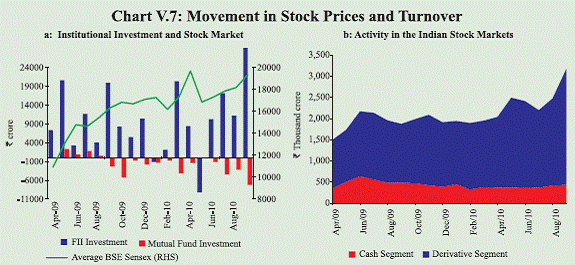 |
V.23 The quarterly House Price Index
(HPI) for various centres based on data
collected from the Department of
Registration and Stamps (DRS) suggests that
property prices are picking up in most tier I
cities though some slowdown is witnessed
in tier II cities (Chart V.8a). According to these data, prices in Mumbai in the last three
quarters are showing moderate growth, while
prices in Delhi are growing at a faster rate,
which partly reflects activities relating to the
Commonwealth Games. The number of
transactions in Mumbai, which had
registered a sharp rise in Q3 of 2009-10 seem
to have reached a plateau. Housing prices in
Bengaluru, which were almost flat for the
past one and half years, are showing some
signs of increase. This was also corroborated
by the trends on NHB Residential Price
Index (Chart V.8b).
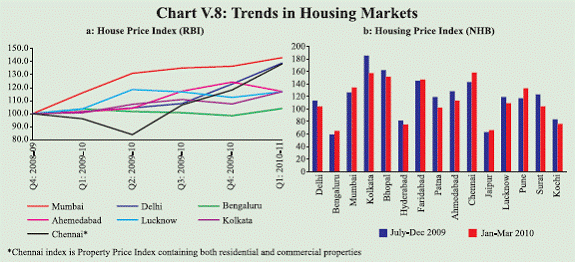 |
V.24 The growing risk perceptions and
uncertainty in the global markets impacted
Indian financial markets through two
different channels viz. pressure for
appreciation of the Indian Rupee and rise in
equity prices due to sharp rise in portfolio
flows. Despite global market uncertainties,
domestic markets functioned normally, with
stable volumes and lower volatility. The
transmission of higher policy rates were
visible in higher issuances of CDs, CPs as
also higher yields on TBs and G-Sec and even in deposit rates. Lending rates have also
started to move up, with a lag. In the Base
Rate environment, there have been signs of
corporates increasing their dependence on
the CPs market. Banks have also used the
CDs route to mobilise bulk deposits. Given
the outlook for possible significant large
increase in portfolio flows to EMEs in the
near term, their impact on exchange rate and
asset prices will have to be closely monitored
because of their implications for domestic
inflation and external competitiveness. |